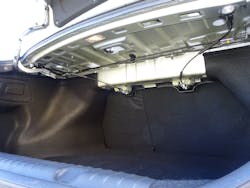University of Extrication: Skills Update—Trunk Torsion Rods & Lifter Struts
Subject: Skills Update—Trunk Torsion Rods & Lifter Struts
Topic: Trunk & Liftgate/Hatchback Ops
Objective: Adapt and update rescue tasks when dealing with trunk and liftgate/hatchbacks to address the presence of trunk torsion rods and powered lifter struts.
Task: In a training environment, the rescue team shall 1) Force open the trunk of a sedan and remove the trunk rods without cutting them and 2) Force open a vehicle’s liftgate or hatchback unit and remove both lifter struts.
Our 2017 Skills Update series continues with a look at trunk and liftgate or hatchback vehicle rescue evolutions. With sedans, rescuers must be aware of what function trunk torsion rods perform and where these rods are located within the trunk area.
A pair of trunk torsion rods can be found mounted along the underside of the rear speaker deck within the trunk area itself. These torsion rods lift the trunk lid upward as the trunk latch is opened. To do this, the pair of spring steel trunk torsion rods are tensioned when installed into their brackets beneath the rear speaker deck.
The steel used to form these rods is capable of significantly damaging the cutting edge of the blade of a power cutter tool. It is recommended that when encountering trunk torsion rods that need to be removed, that they be disconnected by prying them free from the lightweight metal brackets holding them at each end. Removal at these attachment points can be quick and effective. It also eliminates any chance of cutter blade damage because no cutting of these rods was involved. Make sure your trunk torsion rod policy is “Pry them out—Don’t cut them”.
Lifter struts
When a hatchback or liftgate unit is opened, instead of torsion rods, you encounter a pair of pressurized pneumatic lifter struts; one on each side. There is an inert pressurized gas inside the “fat” part of each strut. Pressures can range from several hundred psi to several thousand psi. There is also a quantity of mineral oil inside the fat part of the lifter strut. When dealing with vehicles that have a liftgate, hatchback, or even certain trunk or hood designs, there are several skills that rescuers can update when these lifter struts need to be removed.
Crews need to review how these lifter struts are secured at both the top and bottom and be proficient at safely and efficiently disconnecting or detaching them. Attachment styles differ, but typically the forked end of a Halligan Bar will pop the lifter strut free. If the attachment is the common “ball-end” style, a small prying tool or even a flat-bladed screwdriver can release the spring clip that holds the end of the lifter to the vehicle or liftgate itself.
If a rescue crew decides to cut a lifter strut to remove it, remember the solid rod portion of the strut is the portion that can be cut through without issue. Do not cut the fat part; that’s where the stored pressure is. Cutting into this portion could yield an uncontrolled strut failure.
Newer model SUVs and crossovers may also have one of their two lifter struts designed as an electrically powered strut. Rescuers need to be able to identify this special strut and also know how to safely remove it at an incident scene.
A powered lifting strut unit is controlled electrically and allows the vehicle owner to remotely open and close the liftgate unit. Look for any thin-gauge wiring running to one of the struts. Also, look for a strut that might be larger than the other or the presence of a power button on the liftgate itself. These are good indicators that you are dealing with an electrically powered lifter strut. Besides the pressurized oil design, an electrically powered lifter strut could have a giant spring inside; compressed and under considerable force. Be careful with this new technology feature when disconnecting a powered lifter strut from the liftgate or hatchback.
Characteristics of a Lifter Strut
- Found in hatchbacks or liftgates
- One found on each side
- Contain inert pressurized gas inside the “fat” part
- Pressures range from several hundred to several thousand psi
- Fat parts also contain a quantity of mineral oil
About the Author
Ron Moore
RON MOORE, who is a Firehouse contributing editor, recently retired as a division chief with the McKinney, TX, Fire Department and now serves with Prosper, TX, Fire Rescue. He self-published the Vehicle Rescue 1-2-3 training manual and serves as the forum moderator for the extrication section of Firehouse.com . Moore can be contacted directly at [email protected].

